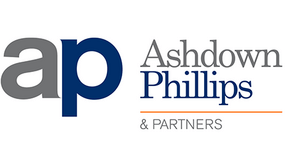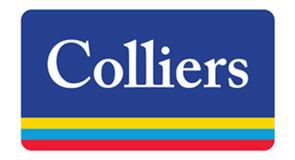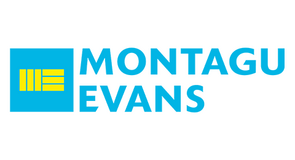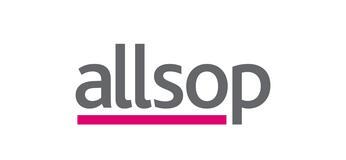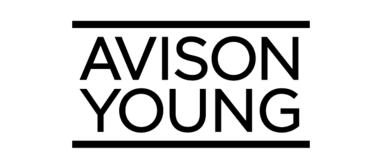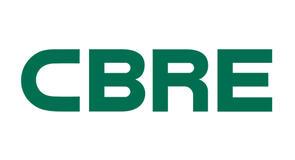GN 5.4: Water efficiency opportunities
Guidance Note purpose
The purpose of this Guidance Note is to provide asset managers, property managers and facilities managers with guidance on opportunities to improve the water efficiency of commercial buildings.
Context
Water efficiency opportunities will vary depending on the individual property. However, referencing the water management hierarchy can help to prioritise general water efficiency opportunities for further development.
Water management hierarchy
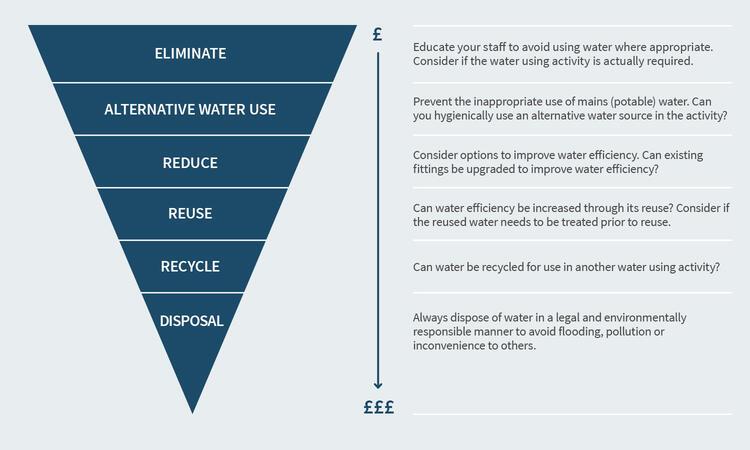
Importance
The Water and Resources Action Partnership (WRAP) estimate that commercial businesses can reduce their water bills by up to 33% if they manage water more effectively1. Water efficiency, therefore, provides an important contribution towards meeting the Government’s target of reducing leakages by 50% by 2050 and towards anticipated future targets relating to water usage.
Responsibilities & Interests
The table below summarises the key activities associated with water efficiency opportunities, and highlights where asset managers, property managers and facilities managers are likely to have a responsibility or specific interest.
- AM - Asset Manager
- PM - Property Manager
- FM - Facilities Manager
Stage 1: Identify water efficiency opportunities
Stakeholder:
Stage 2: Prioritise the recommendations
Stakeholder:
Stage 3: Determine funding sources
Stakeholder:
Stage 4: Implement water efficiency improvements
Stakeholder:
Stage 5: Monitor and report on improvements
Stakeholder:
How to
Intro
There are a range of water efficiency opportunity types, that include:
- Water efficient fixtures.
- Water usage controls.
- Use of rain, grey and blackwater.
- Metering.
- Occupier engagement.
Different water saving opportunity types will be of interest to, and the responsibility of, asset, property and facilities managers, and occupiers.
Water efficiency opportunities involve the consideration of a number of elements:
Stage 1: Identify water efficiency opportunities
There are different ways to approach the identification of water opportunities. Determining the preferred approach will depend on multiple factors including the asset type, the availability of data, the technology installed and the budget available for investigation works.
If the budget for identifying water efficiency opportunities is limited, the following should be considered:
- Reviewing the existing PPM to identify any recommendations.
- Benchmarking the energy use of the building – review the Better Building Partnership Real Estate Environment Benchmark
- Asking the M&E contractor to conduct a simply review of the operation of the plant in the building.
Stage 2: Prioritise the recommendations
It is likely that a review of potential water efficiency opportunities will provide multiple recommendations, some of which will be more practicable than others.
An exercise to evaluate and prioritise opportunities should be undertaken. This should consider factors such as ease of implementation, cost, payback period and anticipated savings.
Stage 3: Determine how the recommended initiatives are to be funded
It is important to determine whether the whether the asset manager is willing to fund or forward fund any of the recommendations identified by the review of potential water efficiency opportunities which require capital investment. This is likely to depend on a range of factors, including payback period and alignment with corporate sustainability targets.
Another funding option may include the service charge, depending on the recommendation and the provisions within the service charge clause.
Stage 4: Instruct the implementation of appropriate energy efficiency improvements
A property manager is likely to have a responsibility for identifying and instructing the parties who will carry out the water efficiency improvements.
- For capital works, this will involve the procurement of suitable contractors.
- For behaviour change opportunities, engagement with communications and human resource teams within both property and facilities managers, and occupiers, will be important.
Stage 5: Monitor and report on the impact of the improvements
It is important that the water data available for the property is reviewed before an improvement project is implemented. This will enable the creation of a baseline which can be referenced the project has been implemented to assess the extent of water efficiency improvement.
Water efficiency improvement opportunities: examples
There are a number of general areas that support water efficiency. These include:
Water efficiency fixtures
- Water efficient toilets, taps and showers. For example, cistern displacement devices and aerated taps.
- Urinals: For example, hydraulic valve installations, passive infrared sensors, manual quarter- turn ball valves, timers, cistern volume adjusters and waterless urinals.
- Toilets: For example, leak detection, drop valve mechanisms, cistern valve mechanisms, cistern volume adjusters, dual flushing, adjusting position of the ball float, siphon mechanisms, cistern dam partitions, delayed action inlet valves.
- Flow controllers. Water is often delivered to taps at a much higher pressure than necessary, which leads to a higher rate of usage. Pressure-reducing valves can be used to control the pressure in the incoming mains or the distribution system.
- Washroom taps: For example, isolating ball valves, flow restrictors, spray taps, tap aerators, push taps, electronic taps/infrared sensors, eco taps or eco brake cartridges, thermostatic mixer valves.
Metering
Meters and monitoring systems. For example, sub-meters and/or flow-meters can be purchased or hired in order to calculate consumption or flow data for key equipment or process lines.
Rain, grey and blackwater
Water that is supplied by water companies is required by law to be of a potable standard, which means it is suitable for drinking purposes. However, it is estimated that around 80% of water supplied to commercial premises is used for purposes for which a potable standard is not required. Hence, the treatment applied to achieve potable water standards is, in effect, unnecessary.
In order to reduce the demand for purchased potable water to a site or building, the following sustainable water systems could be considered for installation:
Rainwater harvesting: Capturing rainwater at the point it falls, storing it and then using it for non-potable sources. Many roofs of commercial buildings have a high water harvesting potential.
Greywater: Water from showers, basins and laundries directed to a water harvesting tank and then fed to the cistern. This water is usually only used for toilet flushing, as it is not as clean as rainwater
Blackwater: Water from sewage and wastewater treatment plants. This is treated on site rather than going into the mains drainage system.
Benefits relating to the use of rainwater, grey or black water include:
- Reducing costs associated with purchasing supplies from a water company.
- Reducing the energy consumption and CO2 emissions associated with a building’s water use.
- Rainwater harvesting reduces flash-flood risk associated with heavy rainfall.
- Use of grey and black water reduces the amount of sewerage discharge and the associated financial costs.
Behaviour change
Encouraging a property’s occupiers to adopt basic good practice procedures can also help to reduce use and should be encouraged. Examples include:
- Using soap ‘foam’ to speed up rinsing hands.
- Ensuring taps are not left running unnecessarily.
- Ensuring dishwashers are full before operating.
Related Guidance Notes
The following Guidance Notes contain related information:
- GN1.3: Environmental aspects and impacts
- GN4.4: Advanced metering
- GN4.5: Energy consumption profile
- GN4.8: Template action plan
- GN4.10 Maintaining sustainable energy and water assets
- GN5.1: Leak inspections
- GN5.2: Undertaking a water audit
- GN5.3: Benchmarking water use and setting targets
- GN11.1: Building User Guide
- GN11.2: Engaging occupiers
- GN11.3: Service charge considerations
Additional Resources
Solutions Scrapbook

Executive Assistant to the CEO
Intro: Creating a water meter inventory and consumption baseline
Creating a water meter inventory and consumption baseline
Establishing a water meter inventory for a property, and the consumption through those meters, enables a consumption baseline to be established, against which improvement targets can be set.
The following steps should be followed in order to establish a building’s baseline water usage:
